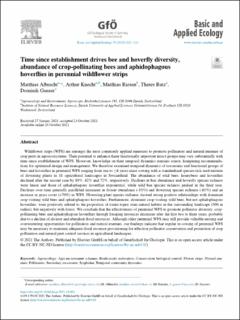Please use this identifier to cite or link to this item:
https://doi.org/10.21256/zhaw-28406| Publication type: | Article in scientific journal |
| Type of review: | Peer review (publication) |
| Title: | Time since establishment drives bee and hoverfly diversity, abundance of crop-pollinating bees and aphidophagous hoverflies in perennial wildflower strips |
| Authors: | Albrecht, Matthias Knecht, Arthur Riesen, Matthias Rutz, Theres Ganser, Dominik |
| et. al: | No |
| DOI: | 10.1016/j.baae.2021.10.003 10.21256/zhaw-28406 |
| Published in: | Basic and Applied Ecology |
| Volume(Issue): | 57 |
| Page(s): | 102 |
| Pages to: | 114 |
| Issue Date: | 28-Oct-2021 |
| Publisher / Ed. Institution: | Elsevier |
| ISSN: | 1439-1791 |
| Language: | English |
| Subjects: | Agroecology; Agri-environment schemes; Biodiversity restoration; Conservation biological control; Flower strips; Natural enemies; Pollinators; Secondary succession; Syrphidae; Temporal community dynamics |
| Subject (DDC): | 333.7: Land, natural recreational areas 577: Ecology |
| Abstract: | Wildflower strips (WFS) are amongst the most commonly applied measures to promote pollinators and natural enemies of crop pests in agroecosystems. Their potential to enhance these functionally important insect groups may vary substantially with time since establishment of WFS. However, knowledge on their temporal dynamics remains scarce, hampering recommendations for optimized design and management. We therefore examined temporal dynamics of taxonomic and functional groups of bees and hoverflies in perennial WFS ranging from one to ≥6 years since sowing with a standardized species-rich seed mixture of flowering plants in 18 agricultural landscapes in Switzerland. The abundance of wild bees, honeybees and hoverflies declined after the second year by 89%, 62% and 72%, respectively. Declines in bee abundance and hoverfly species richness were linear and those of aphidophagous hoverflies exponential, while wild bee species richness peaked in the third year. Declines over time generally paralleled decreases in flower abundance (-83%) and flowering species richness (-61%) and an increase in grass cover (+70%) in WFS. Flowering plant species richness showed strong positive relationships with dominant crop-visiting wild bees and aphidophagous hoverflies. Furthermore, dominant crop-visiting wild bees, but not aphidophagous hoverflies, were positively related to the proportion of (semi-)open semi-natural habitat in the surrounding landscape (500 m radius), but negatively with forest. We conclude that the effectiveness of perennial WFS to promote pollinator diversity, crop-pollinating bees and aphidophagous hoverflies through foraging resources decreases after the first two to three years, probably due to a decline of diverse and abundant floral resources. Although older perennial WFS may still provide valuable nesting and overwintering opportunities for pollinators and natural enemies, our findings indicate that regular re-sowing of perennial WFS may be necessary to maintain adequate floral resource provisioning for effective pollinator conservation and promotion of crop pollination and natural pest control services in agricultural landscapes. |
| URI: | https://digitalcollection.zhaw.ch/handle/11475/28406 |
| Fulltext version: | Published version |
| License (according to publishing contract): | CC BY-NC-ND 4.0: Attribution - Non commercial - No derivatives 4.0 International |
| Departement: | Life Sciences and Facility Management |
| Organisational Unit: | Institute of Natural Resource Sciences (IUNR) |
| Appears in collections: | Publikationen Life Sciences und Facility Management |
Files in This Item:
| File | Description | Size | Format | |
|---|---|---|---|---|
| 2021_Albrecht-et-al_Time-since-establishment-drives-bee-and-hoverfly-diversity.pdf | 1.25 MB | Adobe PDF |  View/Open |
Show full item record
Albrecht, M., Knecht, A., Riesen, M., Rutz, T., & Ganser, D. (2021). Time since establishment drives bee and hoverfly diversity, abundance of crop-pollinating bees and aphidophagous hoverflies in perennial wildflower strips. Basic and Applied Ecology, 57, 102–114. https://doi.org/10.1016/j.baae.2021.10.003
Albrecht, M. et al. (2021) ‘Time since establishment drives bee and hoverfly diversity, abundance of crop-pollinating bees and aphidophagous hoverflies in perennial wildflower strips’, Basic and Applied Ecology, 57, pp. 102–114. Available at: https://doi.org/10.1016/j.baae.2021.10.003.
M. Albrecht, A. Knecht, M. Riesen, T. Rutz, and D. Ganser, “Time since establishment drives bee and hoverfly diversity, abundance of crop-pollinating bees and aphidophagous hoverflies in perennial wildflower strips,” Basic and Applied Ecology, vol. 57, pp. 102–114, Oct. 2021, doi: 10.1016/j.baae.2021.10.003.
ALBRECHT, Matthias, Arthur KNECHT, Matthias RIESEN, Theres RUTZ und Dominik GANSER, 2021. Time since establishment drives bee and hoverfly diversity, abundance of crop-pollinating bees and aphidophagous hoverflies in perennial wildflower strips. Basic and Applied Ecology. 28 Oktober 2021. Bd. 57, S. 102–114. DOI 10.1016/j.baae.2021.10.003
Albrecht, Matthias, Arthur Knecht, Matthias Riesen, Theres Rutz, and Dominik Ganser. 2021. “Time since Establishment Drives Bee and Hoverfly Diversity, Abundance of Crop-Pollinating Bees and Aphidophagous Hoverflies in Perennial Wildflower Strips.” Basic and Applied Ecology 57 (October): 102–14. https://doi.org/10.1016/j.baae.2021.10.003.
Albrecht, Matthias, et al. “Time since Establishment Drives Bee and Hoverfly Diversity, Abundance of Crop-Pollinating Bees and Aphidophagous Hoverflies in Perennial Wildflower Strips.” Basic and Applied Ecology, vol. 57, Oct. 2021, pp. 102–14, https://doi.org/10.1016/j.baae.2021.10.003.
Items in DSpace are protected by copyright, with all rights reserved, unless otherwise indicated.